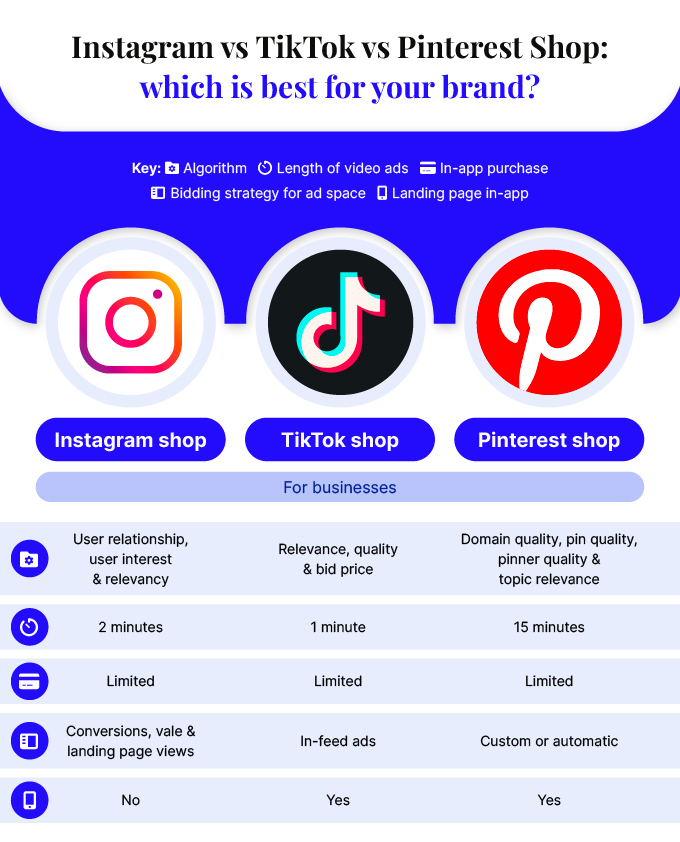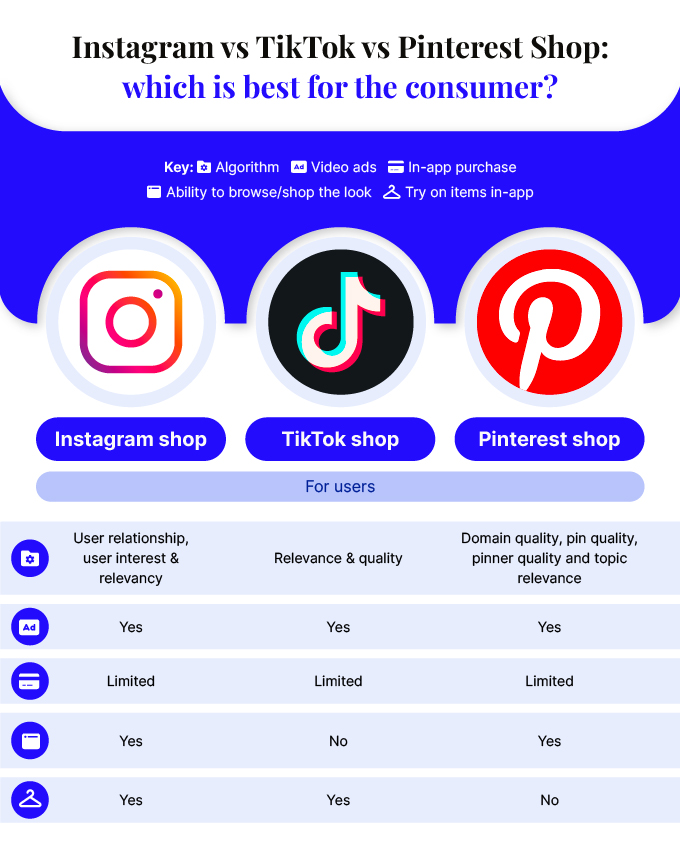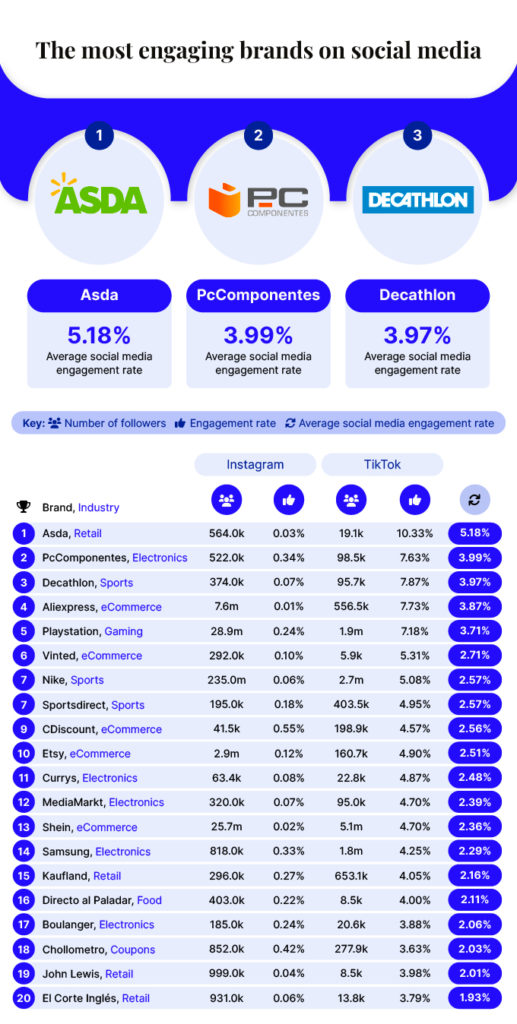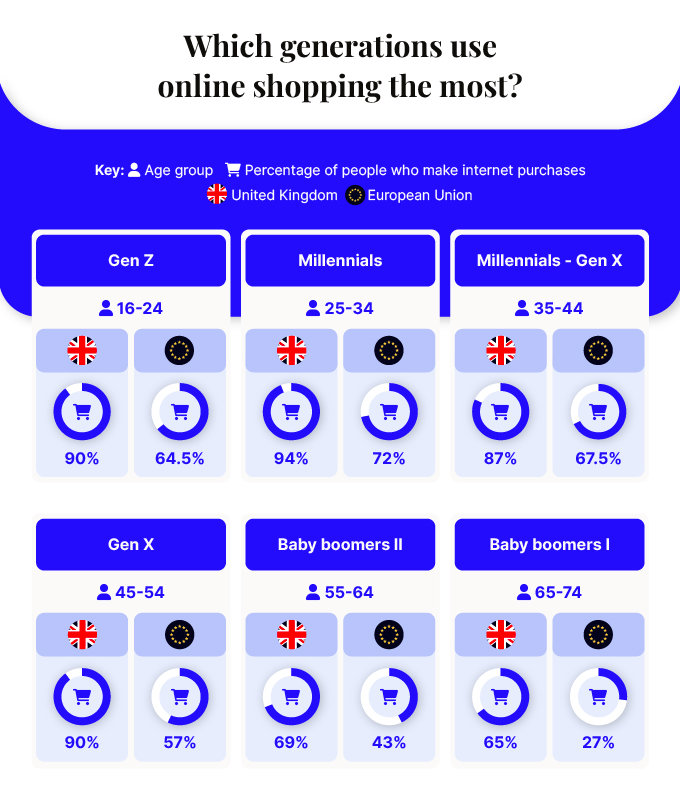Social Media Shopping Study: Which Is the Best Platform for Shopping?
Published on: 08 Sep 2022 | Author: Raluca Zdru

Published on: 08 Sep 2022 | Author: Raluca Zdru
Digital marketplaces have taken over shopping in the last few years, with more and more people abandoning traditional ways of shopping in favour of online and social media purchases.
The visual and interactive benefits of social media shopping have influenced millions of people. In fact, 72% of Instagram users now say Instagram influences their buying decisions, according to a 2017 survey by Dana Rebecca Designs.
Shop functions on Instagram, TikTok and Pinterest are constantly expanding and evolving, making it crucial for businesses to utilise their capabilities to reach new audiences and showcase their products in a more personal way.
Sortlist wanted to find out which social media shop is best for businesses, and for consumers, and look at which generations make the most online purchases.
As a business, you’re always searching for the best way to reach your target consumer and put the spotlight on your products. With so many people today using online shopping and social media growth, having a brand presence on social platforms is one of the best ways to boost your reach.

Instagram, TikTok and Pinterest shops all promote posts to users based on consumer demographics and interests.
However, Pinterest takes into account the ‘quality’ of the pinner, which is based on how often you pin content and how much interaction your pins usually get.

Brands using Pinterest should build a presence on the app by posting, commenting and interacting with consumer posts to maximise their reach.
Although it is usually best to keep video ads short, on Pinterest brands have more freedom to showcase products by taking advantage of the maximum video ad limit of 15 minutes. Shoppable pins on Pinterest support in-app checkout for a limited number of Shopify accounts, boosting the user experience and reducing the need for your business to have a website. Pinterest shop supports businesses having an in-app shop profile page, so users can get to know your brand identity by viewing all of your available products in one place.
On TikTok, posts are promoted to users based on relevance and quality. TikTok ads often favour high-paying brands, showing in-feed ads based on the bid price.

TikTok shop supports in-app purchases for most accounts, although sellers can choose to redirect customers to their external domain. Improving the user experience, in-app shopping means users can build a shopping cart of items from different brands which makes for a more seamless checkout experience.
On TikTok, users can view all available products from an account, by navigating to the shop tab on the account profile.
Posts on Instagram are shown to users based on the user’s following list, post relevancy and user likes. For businesses, that means users who follow or interact with similar brands are more likely to see your available items.

On Instagram, adverts are shown to users based on their following list and interests, making it ideal for brands. Videos on Instagram can be as long as two minutes and can take the form of a story, reel or post. Instagram shop allows eligible US-based businesses to integrate in-app purchases, however, this function is not available for worldwide accounts. Instagram shop does not yet support shop profiles, which could make it harder for brands to showcase all their products in one place.
As a consumer, it is becoming easier now more than ever to shop on social media. Just try scrolling your ‘for you’ or explore page on your favourite social media apps, and you could be faced with countless ads, user hauls and brand takeovers, urging you to buy products suited to your interests. But with so many options available for social shopping, it can be difficult to know what the best platform is for finding products.

Based on the current algorithm for Instagram, TikTok and Pinterest, you are more likely to be shown posts that relate to your interests on all three platforms.
Instagram uses your likes and follows to determine what content you are interested in and is more likely to show you posts from the brands you love. Instagram supports video ads, helping you get to know the uses of a product without having to navigate to the brand website or read product descriptions. You can even try on items in-app, like hair dye and makeup, using brand filters, although these are usually temporarily available. Instagram shop is also perfect for browsing, with a dedicated tab making it effortless to search product posts and brand catalogues.
Pinterest shows you posts by taking into account your interaction with the post topic and the rank of the pinner, meaning most of posts you see while scrolling are relevant to your interests.
Given Pinterest’s image search function, it can be easier to find and buy specific products from pictures that you see online, than on Instagram and TikTok. Pinterest’s ‘shop the look’ function makes it easier than ever to recreate outfits you see on pins, meaning you could bring your style inspiration board right into your wardrobe.
The TikTok ads on your ‘for you’ page can be based on your interests, but can also be based on the number of watch loops the video has received and the number of video shares.
The TikTok ads on your ‘for you’ page can be based on your interests, but can also be based on the number of watch loops the video has received and the number of video shares.
On TikTok, you can try on items in-app and brand filters are usually available for longer than the promotional filters used on Instagram. This takes the immersive online shopping experience to a whole new level, giving you even fewer reasons to shop in-store. Finding products on TikTok shop can be more difficult – with no separate search function for shop products, it could take longer to find products than on TikTok or Instagram.

Asda is one of the most visited eCommerce sites in the UK, with 12,951,842 website views in July. Carrying products from food to home appliances and living goods.
Although Asda has fewer social media followers than some of the brands on our list, Asda’s Instagram engagement rate is 0.03% and on TikTok, it is 10.33%, giving an average engagement rate of 5.18%.
PcComponentes is one of the largest technology e-commerce companies in Spain, specialising in electronic and home products. In July, it received 16,855,576 page visits.
One of the most engaging brands on social media, PcComponentes has an average engagement rate of 0.34%, based on 1.4% Instagram engagement and 7.63% on TikTok.
Decathlon is one of the largest sporting equipment retailers in the world, and its presence online is undeniable, with 22,747,189 visits to the French site and 15,918,983 to the Spanish site in July.
On social media, Decathlon’s influence is shown through its engagement rate of 0.07% on Instagram and 7.87% on TikTok, averaging 3.97%.
Ecommerce has been booming in popularity over the last few years, with an exponential increase in the number of consumers that are now choosing to shop online instead of in-store.
The success of online and mobile shopping is due in part to its convenience, with shoppers preferring to browse from the comfort of their own homes, and avoid busy shops and waiting in line.
Another advantage of internet shopping is the vast and extensive product range available from some retailers online, in contrast to in-store shopping space which limits the number of items that can be displayed.
We found that online shopping in the UK is most popular with those aged 25-34, or millennials, with around 94% of consumers having made an online purchase in 2020-21.
Following closely behind, Gen X and Gen Z make far more online purchases than baby boomers in the UK. Around 90% of those aged 45-54 and 16-24 bought something online during 2020-21. Among the older millennials and younger Gen Xers aged 35-44, around 87% made an online purchase from 2020-21.
Following these trends, millennials make more online purchases than any other generation in the European Union, with 72% of those aged 25-34 in each EU country having bought something online between 2020-21.
We found that in the EU, among older millennials and younger Gen Xers aged 35-44 around 67.5% made an online purchase during 2020-21, with Gen Z following closely behind at 64.5%.
The power of online shopping should not be underestimated by any brand, and social media is one of the key ways to reach your target audience. With such a wide range of age groups using internet shopping, retailers can use social media profiles and adverts to target consumers of certain age groups and interests, for maximum impact.
Although baby boomers across the UK and EU are the least likely of all generations to shop online, over 3/5 (65%) of those aged 65-74 in the UK made an online purchase from 2020-21. In comparison, 27% of the same age group in the EU make online purchases.

We found that Instagram, Pinterest and TikTok shop are all booming in popularity, with users abandoning traditional shopping for online and social purchases. Each social media shopping platform reaches a different audience and business success can be achieved through promoting products and establishing a brand presence.
Instagram shop has time on its side and it shows – first launching in 2019 Instagram shop has a browsing tab similar to the app’s explore page and allows for seamless product integration for Shopify users. Consumers can easily find products that relate to their interests and the brands they love.
Pinterest shop stands out with its ‘shop-the-look’ and image search functions, making recreating outfits and finding things to buy easier than ever for consumers. TikTok shop lacks the ease of browsing found on Instagram and Pinterest shop, which could make it harder for consumers to find products, although brands can benefit from the reach of the app’s in-feed ads.
We wanted to compare Instagram, TikTok and Pinterest shop and find which generations use online shopping the most.
We sourced the percentage of each age group that made an online purchase from Eurostat, by taking an average for 2020 and 2021 and looking at the United Kingdom and countries in the European Union.
We also wanted to find which brands receive the most engagement on Instagram and TikTok, so we compiled a list of the biggest eCommerce retailers in the UK, France, Spain, Germany and Italy as of July 2022 using Semrush. Those retailers for which we could not obtain the relevant information were removed from our list. We sourced the Instagram engagement rate for each brand from InfluencerMarketingHub and the TikTok engagement rate from InBeat on 31st August 2022.
We sourced information on Instagram shop from DigitalMarketingCommunity, Shopify, Instagram and MWI.
We sourced information on TikTok shop from InfluencerMarketingHub, Tik Tok and SearchEngineJournal.
We sourced information on Pinterest shop from Vimeo and MarinOne.
The Sortlist Data Hub is the place to be for journalists and industry leaders who seek data-driven reports from the marketing world, gathered from our surveys, partner collaborations, and internal data of more than 50,000 industries.
It is designed to be a space where the numbers on marketing are turned into easy-to-read reports and studies.